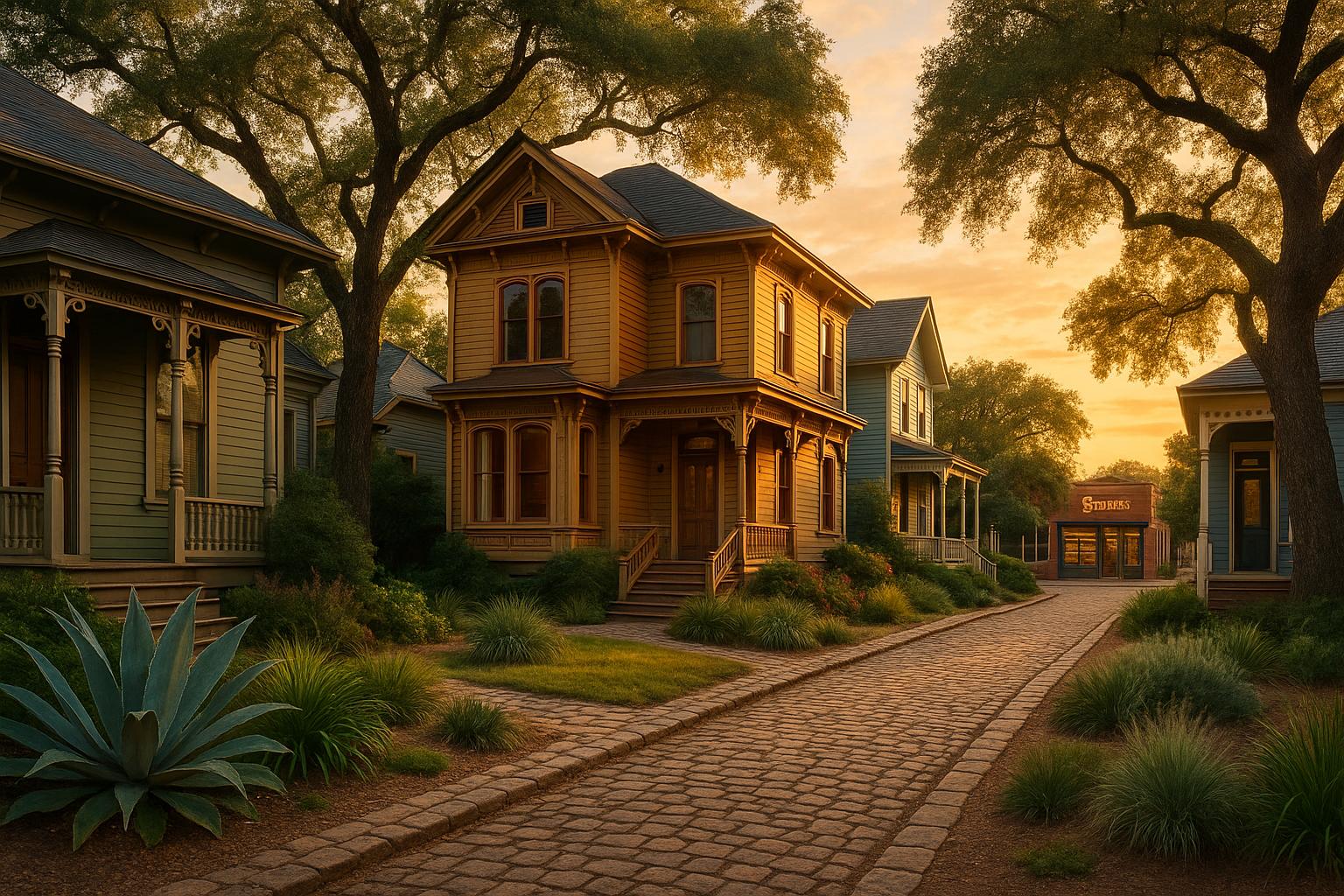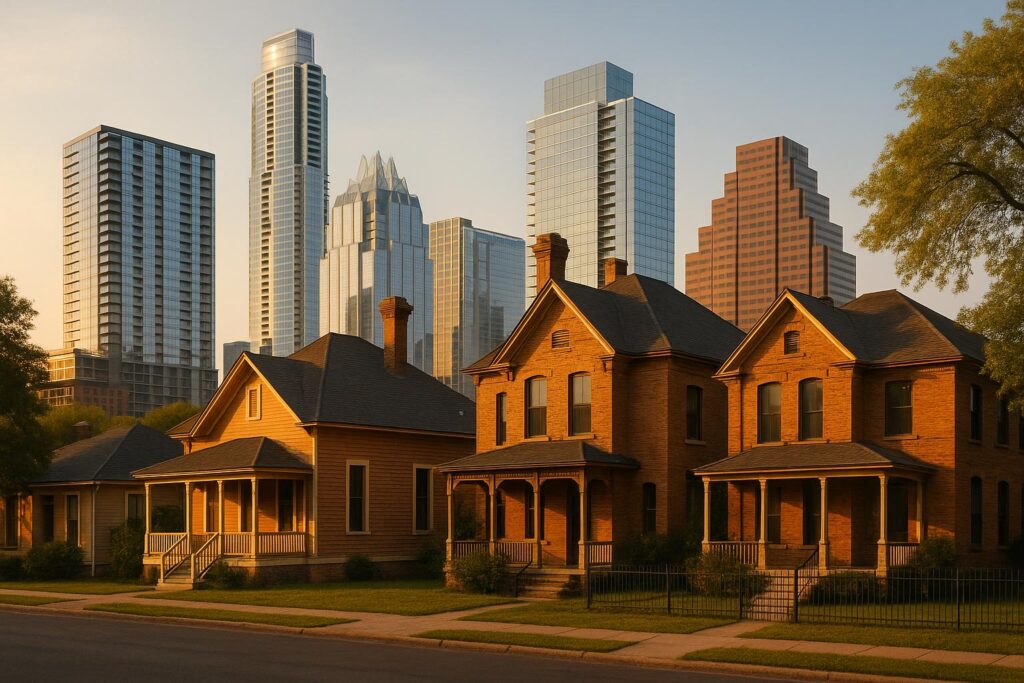Historic preservation in Austin isn’t just about saving old buildings – it’s a smart way to grow the city while maintaining its unique identity. Here’s why it matters for real estate:
- Higher Property Values: Homes in historic districts, like Aldridge Place, often appreciate faster than newer developments.
- Tourism and Jobs: Preserved sites attract tourists, boost local businesses, and create jobs in construction and renovation.
- Smart Urban Growth: Reusing old buildings limits urban sprawl and protects open spaces.
- Community Character: Restoring landmarks, especially in areas like East Austin, keeps Austin’s heritage alive and fosters community pride.
Programs like tax credits, grants, and low-interest loans make preservation easier for developers, proving that history and progress can go hand-in-hand.
Preserving Roots, Cultivating Progress A Sustainable Austin …
How Historic Preservation Solves Urban Problems
Historic preservation in Austin tackles urban growth challenges by giving new life to existing structures. This approach brings specific benefits to the city.
Limiting Urban Sprawl
Reusing existing buildings helps contain outward expansion, creating a more compact city layout. It also protects nearby open spaces, helping Austin grow in a more thoughtful and controlled way.
Preserving Austin’s Character
Preservation isn’t just about buildings – it’s about maintaining the city’s identity. While modern construction changes the skyline, restoring historic landmarks, especially in areas like East Austin, keeps Austin’s heritage alive and fosters a stronger sense of community.
Real Estate Value from Historic Preservation
Higher Property Values
Homes in historic districts often see their values rise more quickly than those in newer developments. For example, areas like Aldridge Place benefit from preserving historic architecture and maintaining the neighborhood’s character. This creates a perception of exclusivity, which drives up property values and opens the door to other economic advantages.
Tourism Income
Austin’s historic sites play a big role in attracting tourists. These visitors, drawn by the city’s rich heritage, spend money at local businesses, helping the economy thrive. This increased tourism not only boosts nearby property values but also strengthens the connection between preservation efforts and real estate growth. On top of that, the tourism industry supports a variety of jobs, further enhancing local economic activity.
Job Growth
Restoration and preservation projects generate jobs in construction, renovation, and tourism. These opportunities lead to higher incomes and increased demand for real estate, creating a cycle of economic growth tied to historic preservation.
sbb-itb-4c99469
Making Historic Preservation Work in Real Estate
Converting Old Buildings
Repurposing historic buildings into boutique hotels, mixed-use developments, or modern office spaces helps keep Austin’s architectural charm alive while addressing today’s functional demands.
Support for Developers
Austin offers various programs to assist developers, including tax credits, property tax exemptions, and matching grants. Strategies like Transfer of Development Rights are also available to help offset the costs of rehabilitation. The Historic Preservation Office provides expert guidance and helps streamline the permitting process, making it easier to balance heritage preservation with contemporary development goals. These efforts have contributed to some of Austin’s most celebrated preservation projects.
Austin Success Stories in Preservation
The Foundry II Project
The Foundry II development highlights how historic preservation can work hand-in-hand with modern real estate projects. Cielo Property Group relocated the 1948 Hepcat House – home to Texas’ first Black radio DJ – to 1709 Salina Street, preserving an important piece of Austin’s history. This historic structure was incorporated into a 161,911-square-foot office development, maintaining 87% of the original clapboard siding while adding modern features. The project not only earned LEED Gold certification with 32% energy savings but also brought in $4.2 million annually in tourism revenue. These outcomes showcase how preservation can align with economic and cultural goals.
Fair Development in Historic Areas
Preservation efforts in Austin also focus on balancing cultural heritage with community needs. The 2024 Equity-Based Preservation Plan introduced actionable steps to protect long-term residents and uphold community character. One example is the Holly Street Murals district project, where three 1920s bungalows were converted into mixed-income housing. The original facades were preserved, and six long-term residents benefited from rent stabilization agreements.
The city’s Equity Preservation Initiative supports these efforts with:
- $500,000 in annual grants for tenant assistance and contractor training
- 2.5% APR loans that have preserved 12 historic homes
- 30-year deed restrictions to ensure affordable rates
In East Austin, preserved commercial buildings now host 42% more minority-owned businesses compared to newer developments.
Another success story is the McFarland House at 3805 Red River Street. This 1947 structure was transformed into Preservation Austin‘s headquarters through a $1.8 million adaptive reuse project. The renovation created 12 local construction jobs and retained key original features like pine flooring and art deco fixtures while adding necessary modern updates.
Historic districts also show strong property value growth. For instance, the Bremond Block Historic District has seen property values rise 23% higher than nearby areas. These examples demonstrate how preserving history can enhance real estate value while maintaining the character of Austin’s neighborhoods.
Next Steps for Austin’s Historic Real Estate
Investing in Austin’s historic neighborhoods offers a chance to combine financial growth with preserving the city’s rich heritage. By building on Austin’s preservation efforts, you can increase property value while respecting the area’s unique character. Here are some practical tips to help you navigate this market effectively.
- Know the Rules: Familiarize yourself with local historic district regulations. This ensures your projects align with preservation standards and maintain the original architectural style.
- Work With Local Experts: Team up with professionals who specialize in Austin’s historic real estate. Platforms like Austin Local Team can connect you with knowledgeable agents, provide instant listing updates, and offer in-depth market insights.
FAQs
How does preserving historic sites increase property values in Austin’s real estate market?
Preserving historic sites in Austin not only protects the city’s unique character but also enhances property values by making neighborhoods more attractive and desirable. Homes and buildings in or near historic districts often see higher demand due to their charm, architectural significance, and cultural appeal.
Additionally, historic preservation helps combat urban sprawl by encouraging the revitalization of existing areas rather than expanding outward. This creates vibrant, walkable communities that appeal to buyers, renters, and investors alike. Over time, these efforts contribute to the overall stability and growth of Austin’s real estate market.
How does historic preservation benefit Austin’s real estate market and local economy beyond tourism?
Preserving Austin’s historic sites does more than just attract tourists – it strengthens the local economy and enhances the real estate market. By maintaining the city’s unique charm and architectural heritage, historic preservation increases property values in surrounding neighborhoods, making them more desirable to buyers and investors.
Additionally, preserving historic areas helps combat urban sprawl by encouraging sustainable development and the reuse of existing structures. This approach supports local businesses, fosters community pride, and ensures Austin retains its distinctive character while continuing to grow. These benefits make historic preservation a key factor in the city’s long-term economic and real estate success.
What incentives and resources are available for developers working on historic preservation projects in Austin?
While specific incentives for historic preservation projects in Austin may vary, developers can often benefit from tax incentives, grant programs, and zoning benefits designed to encourage the restoration and protection of historic sites. These programs aim to balance growth with the preservation of Austin’s unique character and history.
For more detailed information, you may want to explore resources provided by local government agencies or organizations focused on historic preservation. These groups can guide you through available programs and help you navigate the process of preserving Austin’s historic properties.





